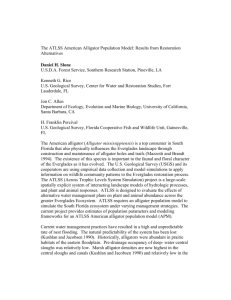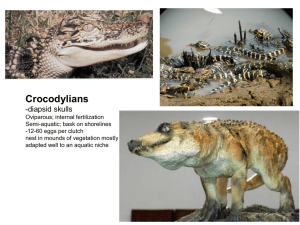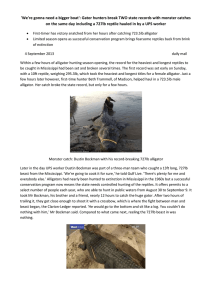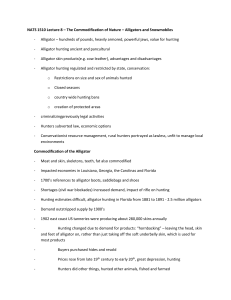AMERICAN ALLIGATOR Alligator mississippiensis
advertisement
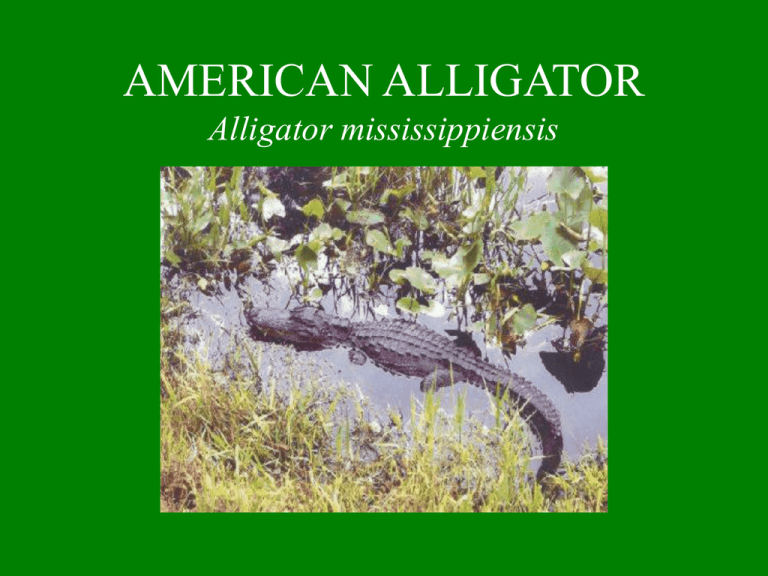
AMERICAN ALLIGATOR Alligator mississippiensis IDENTIFICATION • One of the largest living reptiles • Has a large rounded body with thick limbs • Size: Adult males: avg. length 13-14 ft, occasionally up to 16 ft, weight 400 – 500 pounds Adult females: avg. length 8 – 10 ft and weigh 160 – 230 pounds • Both sexes have “armored body” with a muscular flat tail • Nostrils located on the upper end of snout for “submerged breathing” IDENTIFICATION • ALLIGATOR • CROCODILE • • Broad head – blunt snout Lower teeth do not show with mouth closed Black in coloration Prefer fresh water • Narrow head- long snout • Lower teeth visible when mouth is closed • Brown in coloration • Prefer salt/brackish water • • Alligator mississippiensis Crocodylus acutus LIFE HISTORY • “Living Fossil” from the Age of Reptiles • Has survived for over 200 million years • Market Hunting and Habitat Loss depleted them from most of their natural range (est. 10 million skins taken) • 1967 placed on Endangered List LIFE HISTORY • USFWS, State Agencies, and concerned stakeholders joined forces • KEY TO RECOVERY – multi-discipline management practices • 1987 removed from Endangered List • Today – widely distributed and numerous throughout most of it’s natural range • Listed as Threatened due to: - American crocodile listed as Endangered - Listed on CITES: Appendix II - IUCN Red List: LRIc (low risk, least concern) RANGE & POPULATION • National population: > 1 million naturally occurring • 150 active farming operations • Natural Range: Central America and Southern United States to include; Alabama, Arkansas, North & South Carolina, Florida, Georgia, Louisiana, Mississippi, Oklahoma, and Texas. ECOLOGY • HABITAT - Primarily freshwater edges around swamps, marshes, rivers, lakes, and ponds. - Will venture into brackish or salt water for short periods, lacks the buccal ( salt secreting gland) found in crocodiles. ECOLOGY • FEEDING HABITS: - Carnivorous, opportunistic feeder, will eat anything it can catch. - Hunts primarily in water – will take small mammals at waters edge. - Eats small prey whole – large prey is drowned (tenderized) then eaten in large pieces - Have a specialized valve (glottis) allows for catching prey underwater - Feeding activity ceases if water temperature falls below 20º to 23ºC (68-73ºF) ECOLOGY • FEEDING HABITS: - Preferred Foods Adult: fish, turtles, wading birds, snakes, frogs, carrion, and small mammals. Juvenile: small fish, crustaceans, snails, shrimp, tadpoles, and frogs. - Food for: juveniles are preyed on by snakes, raccoons, wading birds, large fish, otters, osprey, and other alligators. - Consumption: adults consume 20 lbs of meat per week in warm weather – 0 lbs during winter ECOLOGY • BREEDING HABITS: - Breed annually in April and May - Mating occurs in open waters at night - Males and females reach sexual maturity at 6 ft, in length (10-12 yrs of age) - Males roar to attract females and ward off other males - Mature males establish a territory and will service up to 10 or more females and will defend the territory against intruders ECOLOGY • BREEDING HABITS: - Once breeding occurs the female will seek out a secluded location and construct a large mound nest out of muddy vegetation - 1 wk later female lays 30-70 eggs (Jun-Jul) - 60-65 day incubation period - young hatch with aid of egg tooth - the young immediately signal mother with high pitched grunts ECOLOGY • BREEDING HABITS: - Mother will then open the nest and gently carry the young in her mouth to water - Females tend to their young up to 3 years - Young are born 6-9 inches long and have yellow bands for camoflage - Approx. 80% of the young fall to predation ECOLOGY • PHYSICAL ADAPTATIONS: --Large strong jaw has 80 teeth, and is used to capture, crush, and dismantle --Cannot chew – must swallow food whole or in large chunks --Eyes, ears and nostrils are near top of head, with valves to close ears and nostrils when sumerged. This allows the alligator to be able to submerge its entire body and still breath --Can stay submerged 45-60 minutes --Toes are joined at base by webbing --Good binocular vision ECOLOGY • LOCOMOTION: -- Moves efficiently in water, swimming with serpentine movement of body and tail, uses hindfeet as rudders -- On land, slides on its belly, walks or gallops for short distances • HEAT REGULATION: -- Ectothermic -- Lies on the banks to bask in sun for warmth -- Submerges in heat of day to cool off ECOLOGY • ENVIRONMENTAL ADAPTATIONS: -Denning: alligators create dens to survive the dry season and winters – accomplished by digging tunnels into over hanging banks - Icing response: Alligators can survive freezing conditions if they are in water, they submerge their bodies—but keep their nostrils exposed. When the surface freezes they can still breathe. Essentially their upper body becomes trapped in ice. Testimony to their survival ability. TAXONOMY • • • • • • • • • Kingdom: Animalia Phylum: Chordata Subphylum: Vertbrata Class: Reptilia Order: Crocodilia Family: Crocodylidae Subfamily: Alligatorinae Genus: Alligator Species: alligator mississippiensis ECOSYSTEM ROLE • “KEYSTONE SPECIES” -- Controls populations of prey species -- Creates peat beds (old or abandoned nest) providing for Red-bellied turtle (Chrysemys nelsoni) nesting sites -- #1 Value “Gator Holes” fill with water during rainy season and hold water well into the dry season – creating miniature wetlands that provide critical habitat for a variety of species ECONOMIC ROLE • NEGATIVE IMPACTS: -- Threat to humans – in highly populated areas have been known to eat pets and small children -- “Nuisance alligator” programs have been put into place with good success • POSITIVE IMPACTS: -- Tourism $$$$$$$$ -- Hunting revenues – hunted for skins and meat -- Multi-million dollar farming industry – farmed for skins and meat FUTURE RESEARCH AND MANAGEMENT • American alligator is the best studied species of crocodalian • Research is currently being conducted by private, industrial, governmental, and educational institutions in the following areas; population size, distribution and trends, animal sizes, sexes, activity periods, growth rates, and reproduction efforts, diet, nutritional energetics, responses to thermal effluent from reactors into cooling reservoirs, uptake of radionucleides, genetic patterns, and the conservation of the species. SAFETY NOTES 1) Don’t feed the alligators 2) Keep your distance 3) Never disturb nest or small alligators 4) Keep your pets and children away from alligators 5) Don’t swim in areas that are known alligator habitats 6) Be cautious when fishing in waters with alligators

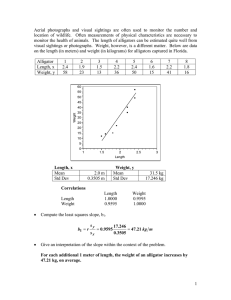
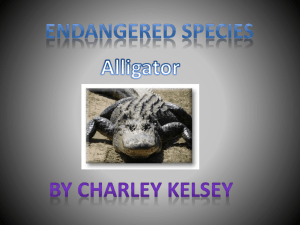
![Chapter Overview 4] Biodiversity and Evolution: Chapter Overview](http://s3.studylib.net/store/data/007156354_1-fad095015625514dd60c5e2467fa2168-300x300.png)
